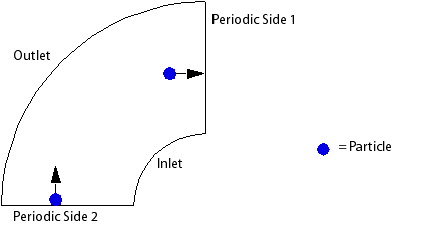When there is no frame change across a fluid-fluid domain interface, then particles simply cross the interface and continue in the next domain.
At a frozen rotor domain interface, particles simply cross the interface and continue in the next domain. You should not use a frozen rotor interface unless particles cross the interface approximately uniformly. For example, if most of the particles cross the interface at one location, then the transient behavior due to the relative motion of the two components will be completely lost. This is the same limitation that applies to local fluid features at frozen rotor domain interfaces. For details, see Frozen Rotor.

When a particle crosses a stage interface, it enters the new domain at a random location and its velocity is rotated accordingly. This is in addition to change in the relative velocity that occurs due to the particle changing to a new frame of reference. This can be thought of as equivalent to the circumferential "averaging" that is performed for the fluid flow variables at stage interfaces. For details, see Stage (Mixing Plane).
If a pitch change occurs across the interface, the mass flow rate is updated appropriately. The balance sections of the CFX-Solver Output file that is written by the CFX-Solver as the solution proceeds reflect these changes.
In a transient simulation, interfaces between rotating and non-rotating domains are modeled using the Transient Rotor Stator frame change option.
When particles cross such an interface, they continue at the corresponding position across the interface. This is similar to the approach used for the Frozen Rotor interface option but the correct, time dependent relative position of the two domains is taken into account. Due to the fact that rotating domains are rotated in CFD-Post, particle tracks will be contiguous across transient rotor interfaces.



